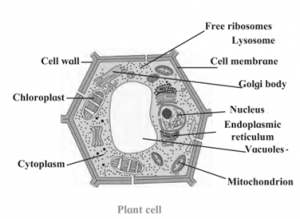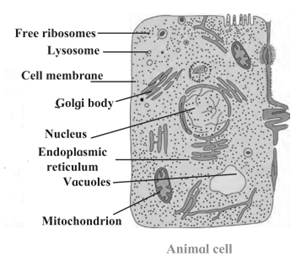Cell Structure and Micro-organisms
Based on Maharashtra Board General Science Chapter 11-Audio Notes, Solution, Video, PDF, Test
Solutions
Question 1:
Answer the following questions. Cell is the fundamental structural and functional unit of living organisms. Cellular organization is the primary characteristic of all living organisms. Cell ->Tissue -> Organ -> Organ System -> Body – Living Organisms. The discovery of cells was first made by Robert Hooke. While examining a section of a cork under the microscope, he observed small compartment-like structures and named them cells. However, Hooke observed dead cells under the microscope as cork is made up of dead cells. The body of all living organisms is made up of minute component called cell. The number of cells are different and specific for every living organism.
(a) What is a 'cell' ?
(b) Name the different organelles in a cell ? Name of the cell organelles are : Nucleus, Cell membrane, cell wall, vacuole, plastids, endoplasmic reticulum, chloroplast, Golgi body, ribosomes, mitochondria, nucleus, lysosomes, centrosome and inclusion bodies.
(c) What are micro-organisms ?
The living organisms on the earth which are all around us, but we are unable to see them are called micro-organisms. They can be seen only under compound microscope. Microorganisms were observed for the first time by Anton von Leeuwenhoek in 1674, using a microscope of his own.
(d) which are the different types of micro-organisms ?
There are 5 major different types of Microorganisms, like: Bacteria- Bacteria are the most primitive and diverse unicellular organisms found in living world. Because of their unique biochemical pathways and properties, they are of high economic importance to the human beings. Fungi- Fungi is a group of eukaryotic, unicellular as well as multicellular, non-photosynthetic organisms that includes mushrooms, moulds and yeasts. Algae- Algae are a diverse group of aquatic organisms that have the ability to conduct photosynthesis. Protozoa- Many protozoa cause disease in animals and humans. Viruses- Viruses are ultra microscopic and non cellular organisms. They have simple structure having genetic material coated by protein coat. They are obligate parasites and highly pathogenic.
Question 2:
Fill in the blanks with the proper word.
(a) The organelle called the ........... is present in plant cells only.
(b) Garbage is converted into .......... by micro-organisms.
(c) In the cell, photosynthesis is carried out with the help of ............ .
(d) An electron microscope is necessary for the study of ............ .
(a) The organelle called the chloroplast is present in plant cells only. (b) Garbage is converted into compost by micro-organisms. (c) In the cell, photosynthesis is carried out with the help of chloroplast. (d) An electron microscope is necessary for the study of cells .
Question 3:
What is difference between ?
(a) Plant cell and animal cell.
Plant cell
Animal cell
1. Plant cells have cell wall made up of cellulose. Cell wall is the outermost structure in a plant cell.
Animal cells do not have cell wall.
2. The cytoplasm of the plant cells is lesser, granular and not dense.
The cytoplasm of animal cells is more granular and dense.
3. There is a single large vacuole located in centre which pushes the cytoplasm to one end.
The cytoplasm is uniformly distributed in the cell.
4. There are no lysosomes.
Lysosomes are present in the animal cells,
5. The mitochondria are few in number.
The mitochondria are greater in number as compared to the plant cells.
6. Plastids are present only in plant cells.
Plastids are absent in the animal cells. except Euglena
7. They have a single large central vacuole.
Vacuoles are few and temporarily formed.
8. The vacuoles are filled up with cell sap.
The vacuoles are filled with food or excretory matter.
(b) Prokaryotic cell and eukaryotic cell.
Prokaryotic cell
Eukaryotic cell
1
Cells are small in size, about 1 to 10 um in size.
Cells vary in size and are generally larger than those in prokaryotes. about 5 to 100 pm in size.
2
The nucleus of prokaryotic cell is not distinct.
The nucleus of eukaryotic cell is distinct, with nuclear membrane, nucleoli and nucleoplasm.
3
Due to the absence of nuclear membrane, the nuclear material comes in contact with the cytoplasm.
Due to the presence of nuclear membrane, nucleoplasm and cytoplasmn never come in physical contact with each other.
4
The cell organelles if present are without membranes.
The cell organelles are always bound with membranes.
5
There is indistinct nucleoid in which prokaryotic DNA is present. There is a single chromosome.
The nucleus is distinct with more than one chromosomes.
6
Mitochondria are absent in prokaryotic cells.
Mitochondria are present in eukaryotic cells.
7
Chlorophyll is present in the vesicles and not in plastids.
Chlorophyll is always inside the chloroplasts.
8
Prokaryotic cells are found in blue-green algae and bacteria.
Eukaryotic cells are found in highly evolved plants and animals.
Question 4:
Sketch and describe in your own words, the plant cell and animal cell.
Plant Cell : Animal Cell : (1) The outermost covering is plasma membrane. (2) Inside this there is cytoplasm in which the cell organelles are embedded. (3) The cell organelles are as following : Nucleus, Golgi body, endoplasmic reticulum and many smaller vacuoles.


Question 5:
Explain the uses and the harmful effects of micro-organisms.
Microorganisms have found wide scale application in various industries. Some of their applications are: Use of Microorganisms in Food Industry (i) Lactobacillus bacterium promotes the conversion of milk into curd. (ii) Yeast is used in preparation of breads, pastries, and cakes. Use of Microorganisms in Vaccine Production (i) Protection of the body from the attack of various disease-causing microorganisms through vaccines is known as vaccination. (ii) Vaccine includes dead or weakened microbes that trigger the production of antibodies in the body. Use of Microorganisms in Increasing Soil Fertility (i) Blue green algae and Rhizobium are called biological nitrogen fixers. (ii) They fix atmospheric free nitrogen to enhance soil fertility. Harmful Microorganisms These are just few examples which highlight the commercial importance of these microorganisms. However, they are not always beneficial can lead to various kinds of damage. (1) Micro-organisms spoil the food. In hot and humid air there is fugal attack on food. (2) Microbes produce enterotoxins and cause food toxic resulting into food poisoning. (3) Harmful microbes cause diseases in plants, animals and human. Amoebiasis, typhoid, cholera, hepatitis, gastro are caused by water and food borne microbes. (4) Microbes cause diseases like malaria, dengue, elephantiasis, yellow fever, chikungunya, Zika fever, etc. These diseases are caused after mosquito transfers the microbes into human body. Common cold, cough, diphtheria, pneumonia, tuberculosis are diseases of respiratory tract which are caused by microbes
Question 6:
Give reasons.
(a) Diseases spread on a large scale during periods of heavy rainfall and floods.
Diseases spread on a large scale during periods of heavy rainfall and floods because it provides the optimum conditions for the growth of vectors which transmit diseases. After heavy rainfall and floods, the water and food gets contaminated. The water logging causes growth of micro-organisms and house flies. They spread the pathogens rapidly. Water gets accumulated at places and acts as breeding grounds for mosquitoes and other vectors. The humid atmosphere induces food spoilage. Even if flood water recedes, the poodle formed helps in the breeding of mosquitoes. For example, malaria is caused by a virus which is transmitted by a mosquito. All such reasons are responsible for epidemic spread of diseases.
(b) There is a possibility of food poisoning if we eat stale food.
The stale food is likely to have microbes in it. Some of the microbes produce enterotoxins. The enterotoxins cause food poisoning. Bacteria and fungi can infect the foods which are stored for longer duration of time. Therefore there is a possibility of food poisoning if we eat stale food.
(c) Soil is turned over during tilling.
Tilling is a mechanical procedure of agitating soil where the top layer is mixed with the lower layers of soil. There are some useful bacteria in the soil. They help to decompose organic substances into inorganic nutrients. Thereby they produce fertilizers. Some microbes also help in nitrogen fixation. They help the plants to get nitrogen. Thus to have better yleld of crop, the soil is turned over during tilling to mix the bacteria.
(d) Fungus grows quickly in moist or humid conditions.
Fungus does not grow in dry conditions. The fungus needs suitable conditions for the growth. The moist and humid conditions are favourable to it.
(e) A refrigerator is used in almost every home.
Refrigerator is used in almost every home because it prevents the spoilage of food. The harmful microbes do not grow in cold temperatures. they grow only in the temperature range of 15° C to 35° C. Refrigerator has very low temperatures. Food can be stored there without spoiling. Therefore, to store perishable food items refrigerators have become essential in every home.
(f) Bread 'rises' during baking.
Bread rises during baking because of addition of yeast to its dough. Yeast is a type of fungus, It undergoes process of fermentation in the batter of bread and releases carbon dioxide. In the process of fermentation the volume of material rises, Therefore, the bread rises during baking, that makes the dough very soft and fluffy, and thus improves the quality of the bread.
(g) Fodder is soaked in water before offering to cattle.
By adding the fodder into water, it is fermented. By fermentation, the vitamin content rises in the fodder, it also becomes easier for digestion. The cattle is thus well nourished. Therefore, fodder is soaked in water before offering to cattle.
Question 7:
When will you use a simple microscope and when, a compound microscope? Explain in detail how you will use them.
In this way, simple microscope is used for general observations and compound microscope is used for specialized observations that require greater magnification.
simple microscope
compound microscope
observation.
the eyepiece.
| View Notes of this Chapter ← Click |
| Main Page : Class 7th MSBSHSE – General Science - All chapters notes, solutions, videos, test, pdf.
Books : Maharashtra Board-Class 7 Science Text Books – Chapter wise PDF for download Videos : Click to view video playlist of Chapter-11 Previous Chapter : Chapter 10 : Disaster Management - Online Solutions Next Chapter : Coming Soon |
I want your messages
Drop you questions
Drop your question here